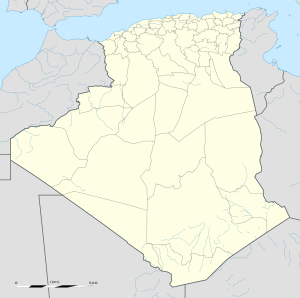Pont Sidi M'Cid
Coordinates: 36 ° 22 ′ 21 ″ N , 6 ° 36 ′ 52 ″ E
| Pont Sidi M'Cid | ||
|---|---|---|
| Pont Sidi M'Cid | ||
| use | Road bridge | |
| Crossing of | Oued Rhumel | |
| place | Constantine (Algeria) | |
| construction | Suspension bridge | |
| Clear width | 160 m | |
| Clear height | 175 m | |
| opening | 1912 | |
| location | ||
|
|
||
The Pont Sidi M'Cid (also Pont Sidi M'Sid , Passerelle Sidi M'Cid ) is a combined cable-stayed and suspension bridge in Constantine (Algeria) , which connects the northern part of the old town at the military hospital across the Oued Rhumel with the Sidi district M'Cid and the Benbadis University Hospital located there. With only one lane and two narrow sidewalks, it is approved for cars and pedestrians.
description
The bridge was originally referred to as a passerelle , suggesting a pedestrian bridge to facilitate funding for access to the hospital. It was built between 1909 and 1912 according to the plans of the French engineer Ferdinand Arnodin and opened on April 19, 1912 in the presence of high French politicians, the same day that the Pont Sidi Rached was opened.
The bridge spans the deeply cut gorge of the Oued Rhumel shortly before its exit at a height of 175 m and was thus the highest bridge in the world until the opening of the Royal Gorge Bridge in Colorado , USA in 1929. It has long been a tourist attraction in all of Algeria. It offers a fascinating view of the even deeper Pont des chutes (waterfall bridge ), which is only 300 m away, and the waterfalls through which the Rhumel leaves the historic city area. Behind it extends the wide hilly landscape around Constantine. On the rocks above the bridge stands the Monument aux morts , a memorial to the dead of the First World War . The rue de la Corniche or N 3 runs on a ledge in the gorge. Below that you can still see the natural bridge from prehistoric times, when the Rhumel crossed the rock plateau underground and the gorge only with the gradual collapse of the ceiling of the watercourse originated.
Technical details
The 164 m long and 5.70 m wide bridge (without the back anchoring) offers the view of a classic suspension bridge from a distance. At both ends of the bridge there are brick pylons, connected in the upper third to form a portal, over which the supporting cables run, each consisting of six individual cables lying next to each other. However, these supporting cables are only connected to the bridge panel in the middle part by vertical hangers. The two outer ends of the bridge panel are stabilized by six stay cables each, which are led over the pylons a little below the supporting cables and are also anchored back.
This combination of a suspension bridge with stay cables is rare. It was introduced by Arnodin to stiffen the bridge deck in order to avoid vibrations caused by the wind or the use of the bridge. Other examples are the Wheeling Suspension Bridge over the Ohio River, opened in 1849, and the bridges designed by John August Roebling , who was very careful about the rigidity of his bridges (e.g. Niagara Falls Suspension Bridge (1855), Cincinnati-Covington Bridge (1867) and his Brooklyn Bridge (1883)).
The Pont Sidi M'Cid has been overhauled several times, most recently in 2000 some ropes were renewed.
Web links
- Le pont suspendu de Sidi M'Cid on Constantine d'hier & d'aujourd'hui , Serge Gilard's private website
- Sidi M'Cid suspension bridge. In: Structurae
- Sidi M'Cid Bridge on Highest Bridges.com


